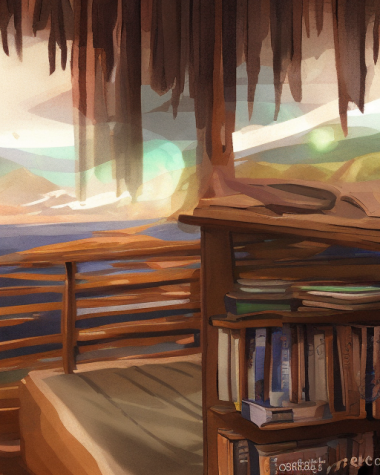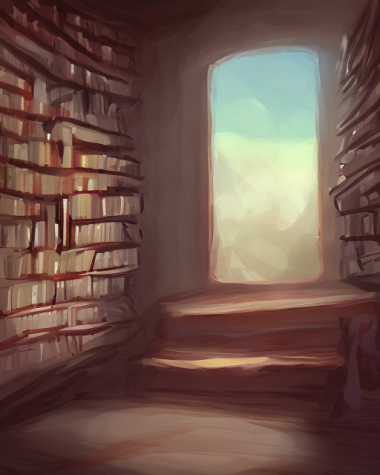We need to wonder where the “art” is in artificial intelligence
March 9, 2023

The current 21st century is characterized by a time of digital development and mechanical progression. There’s no doubt that this age will go down in history as a great technological Renaissance. But while the Renaissance of the past was known to be a rebirth of artistry, the current era may prove to be the death of it. As technology progresses, mechanical inventions have begun to intrude on the sacred human practice of art. In fact, the image to the right was made almost completely by an artificial intelligence program, there was only a minor human role in its creation. The image was generated by an AI, made with the program Starryai. I made it by giving the AI the prompt, “Omniscient Reader’s Viewpoint,” the title of a popular series. Like Starryai, other AI programs have grown rapidly in popularity, and artists fear that this could put their careers in jeopardy.
The rise of AI-generated art has already raised concerns in the art community, to the point where an active campaign has been started against the algorithmic competitor. One of the recent controversies that began such a movement was the incident with ArtStation, a popular art platform. It began frequently featuring AI art on their main page, inciting protest within the art community. Many artists expressed outrage that having AI art appearing on the platform was degrading to the “real” artists that put time and effort into their work. In solidarity with artists across the globe, images of the word “AI ” crossed out in bold red and captioned, “No to AI generated images,” flooded social media and online platforms, including ArtStation. Users have called for ArtStation to ban AI-generated art, but the platform refuses and has been taking down protest images.
Adding fuel to the flames was an AI-made digital painting that won an art competition last year at the annual Colorado State Fair. Jason Allen entered the “digital arts/digitally-manipulated photography” category and took first place with his winning submission, “Theatre D’opera Spatial,” French for “Space Opera Theater.” The news made its way to Twitter, where he received harsh criticism over his so-called “artwork”. Angry tweets accused him of cheating dozens of other artists in the competition. They reasoned that it really isn’t his own artwork, so it shouldn’t be considered an original work in the first place. But Allen defends himself, pointing out that he didn’t break any rules and openly disclosed how the digital painting was made.
The purpose of creating AI was to make breakthroughs in the technological world and improve the daily lives of humans. But as robots and AI become more sophisticated by the day, human workers find themselves being pushed out of their jobs by their automated counterparts. A 2020 World Economic Forum (WEF) report estimated that 85 million jobs would be displaced by robots and machines by 2025. Another thing to take into account is how the pandemic affected the workforce. People had to leave their jobs and stay home to quarantine, so employers were forced to turn to technology to keep their businesses going. The rapid advancement of AI and robots poses a serious threat to human jobs. The art controversy is just the latest development of artificial intelligence encroaching on human activities.
In recent years, AI-generated art has emerged as one of the hottest technology trends. And it seems this trend will be one to stick around. AI art programs, the most popular being Midjourney, DALL-E 2, and Stable Diffusion, are gaining popularity. It has created a buzz, especially on social media, where people go to share their generated creations. Most AI programs work by having a text box to input a prompt, and the AI uses your prompt to produce an image. The prompt can be anything, like “sweet dreams”, “clouds in the sky”, or “raining cats and dogs”. It can be as simple as one word, or multiple words of a phrase. You can also add initial reference images for the AI to work with.
When it comes to making art, human artists pull from their imagination and their mind to produce their masterpieces. Art was considered to be an activity that was so human, as imagination wasn’t something so easily replicated by codes or algorithms. So the question is, how exactly are these artificial intelligence programs creating art, while lacking such an important component? They don’t have an imagination like a human, and they certainly don’t pull it from thin air.
AI programs access the multitude of images from the internet and use those images to learn how to recognize patterns and relationships in art. Essentially, AI uses other people’s art to learn how to make art. Meaning that people uploading their art onto the internet are subject to having their work used, without consent or credit, to train the artificial competitor seeking to take their jobs. It’s this fact that is the center of the ethical argument of whether AI generated art is high tech plagiarism.
Supporters of AI argue that algorithms learning from internet images are no different from how human artists draw influences from the art that they see throughout their lives. An artist creates a painting or drawing by taking inspiration from a lifetime of images they’ve seen. Whether it’s art they see in a museum, in a gallery, or online, do they need to ask for consent in order to be inspired by the things they see in everyday life? Additionally, pro-AI advocates claim that using an AI algorithm is no different from using Photoshop or other digital editing tools. They are simply using the technology at hand to produce their work.
In that regard though, I have to disagree. Editing programs are just tools, it still takes creativity and some sort of skill behind it to use it effectively. A digital designer who has been working with Photoshop for years will produce a higher quality of work than someone who started using it today. But when it comes to AI, you don’t need skill, creativity, or even basic knowledge of art to make something. Even considering that you need to come up with a phrase to feed to the generator, it doesn’t exactly take a lot of thought to type in “sunset” or “grass”, for example. The bottom line is, whether your tool is a digital app or good old-fashioned pen and paper, the human artist is the one behind the creation, not an algorithm or lines of code.
Perhaps the most pressing issue of AI art is the fear that algorithms and codes will eventually replace organic, human art in the near future. Artificial intelligence is improving by the day, because the more it’s used, the more it learns, and the smarter it becomes. And as it is, generated art is becoming more and more indistinguishable from human art. It’s possible that there may come a time when artificial art is considered better than that of a human artist.
I think it’s unlikely that artists will stop painting and drawing just because of the advancement of AI. Those who love to create art will continue to do so; I doubt the rise of AI art will change that. Furthermore, art purchasers will still want to buy human art and human artists will still have their jobs. I highly doubt that we’re going to see the death of artistry just because of this.
However, it does raise some concerns for the future. As the world keeps changing and moving forward, we have to ensure we don’t leave our ideals and beliefs behind. Regardless of how you see it, AI is a growing problem, from a symbolistic and practical point of view. Art copyright is a real issue. Just like a human plagiarist, an AI could copy or at least closely resemble someone else’s work without consent or credit. I understand that human artists also use influences from what they’ve seen throughout their life, but the difference is that a decent human knows how to draw the line between inspiration and plagiarism. And as of now, AI can’t do that. It doesn’t have morals or a conscience; Its sole purpose is to generate what the user asks of it, and will do so by any means necessary. It isn’t capable of crediting its work, and is unaware of what plagiarism is.

At the end of the day, AI art is pretty harmless on its own. It can actually be fun to use, attributing to why it got so popular in the first place. I can see the appeal. After all, I did use it myself when making the images for this article. It’s pretty cool that you’re able to make grand digital paintings and photo-realistic images with just a few clicks of a keyboard. But the issue is when it’s used in the professional or competitive world, such as when it’s sold in auctions or entered into competitions. AI needs to be properly monitored and kept in check to ensure human artists won’t be cheated and stolen from. As technology continues to push the boundaries of what’s possible, there has to be regulations in place to keep it from taking advantage of others.
